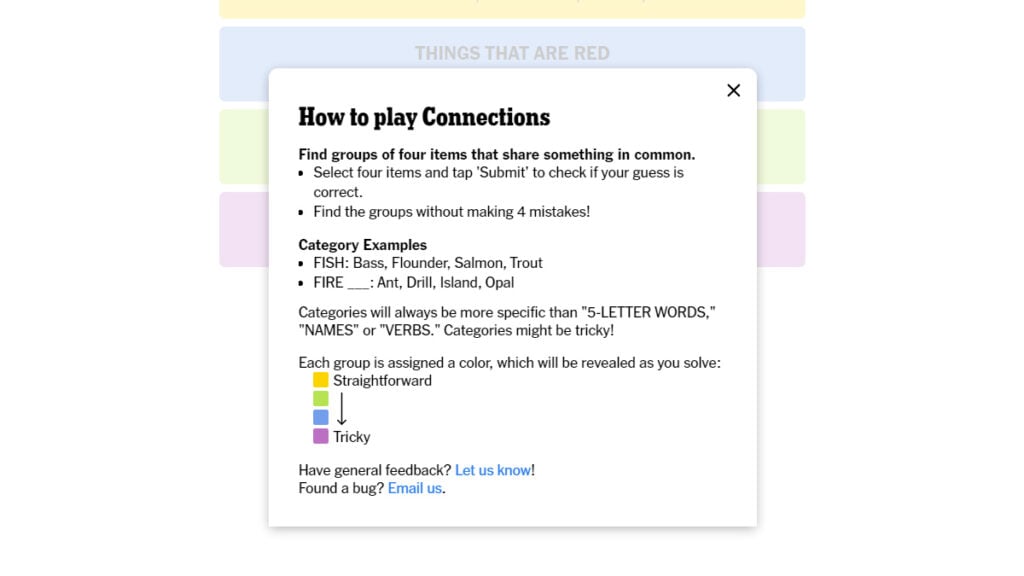The New York Times (NYT) Connections puzzle has taken the world of word games by storm, combining elements of logic, vocabulary, and pattern recognition to create a challenging yet engaging experience for players. As the game evolves, players seek strategies to enhance their performance and enjoy the game more fully. In this article, we will delve into effective tips and hints specifically tailored for the NYT Connections puzzle for April 19, ensuring that you not only solve the puzzle but do so with confidence and skill.
Understanding the NYT Connections Puzzle
Before diving into specific tips, it’s essential to understand the structure of the NYT Connections puzzle. The game typically involves a grid of 16 words, from which players must identify four groups of four words that share a common theme. This can be a category, a word association, or even a more abstract connection.
Key Features of the Game
- Word Grouping: The primary objective is to group the words correctly.
- Time Limit: Players often face a time constraint, adding an element of pressure.
- Multiple Solutions: There may be different valid solutions, adding complexity.
Tips for Success on April 19

Now that we have a foundational understanding of the game, let’s explore specific tips that will help you master the puzzle on April 19.
1. Familiarize Yourself with Common Themes
A significant portion of succeeding in the NYT Connections puzzle lies in recognizing common themes. Here are some prevalent categories you might encounter:
- Colors: Words like “red,” “blue,” and “green” might appear together.
- Animals: Groupings can include terms like “lion,” “tiger,” and “bear.”
- Food: Look for culinary terms such as “bread,” “cheese,” and “meat.”
- Occupations: Words like “doctor,” “engineer,” and “teacher” often appear.
By becoming familiar with these themes, you will become increasingly adept at quickly identifying relationships between words in the grid.
2. Start with Obvious Connections
When faced with a new puzzle, it can be beneficial to begin with the most apparent groupings. Look for words that immediately connect without much thought. This could be as straightforward as identifying a color scheme or a group of animals. For example:
- If you see “cat,” “dog,” “fish,” and “bird,” you likely have an animal category.
- Identifying “red,” “blue,” “green,” and “yellow” can quickly lead you to a color grouping.
Securing these obvious connections early can provide a solid foundation to tackle the remaining words.
3. Use Process of Elimination

If you find yourself stuck, employing a process of elimination can be immensely helpful. Here’s how to approach it:
- Review the remaining words that do not fit into your existing groups.
- Determine which words are less likely to belong to a specific category.
- Rearrange your choices until you find a combination that makes sense.
This analytical approach can often reveal hidden connections that may not have been immediately apparent.
4. Think Outside the Box
Some connections may not be straightforward or fit neatly into preconceived categories. For example, words could have cultural, historical, or even linguistic ties. Here are some examples of less obvious connections:
- Synonyms: Words that mean the same thing might be grouped together.
- Antonyms: Sometimes opposites may form a group.
- Pop Culture References: Look for connections that relate to movies, songs, or books.
Being flexible in your thinking can lead to more successful groupings.
5. Collaborate with Others

While NYT Connections is often a solitary endeavor, collaborating with friends or family can enhance the experience and lead to new insights. Here’s how to make the most of group play:
- Share Ideas: Discuss potential connections and themes.
- Divide and Conquer: Split the words among players to tackle different sections simultaneously.
- Encourage Diverse Perspectives: Different backgrounds can provide uniquely valuable insights.
Collaboration can foster creativity and improve overall performance.
Case Study: Successful Strategies from Top Players
To further illustrate effective strategies, let’s examine a couple of successful players and their approaches:
Player A: The Analytical Thinker

Player A, a graduate student in linguistics, emphasizes the importance of language patterns. They often approach the puzzle by categorizing words based on their etymology or phonetic similarities. For instance, during one session, they identified a common root in several words, leading to swift groupings.
Player B: The Cultural Enthusiast
Player B, a pop culture aficionado, excels at recognizing references from films, songs, and books. While working on a puzzle, they managed to group words based on character names and movie titles, which helped them solve the puzzle in record time. Their ability to draw connections from various cultural domains provided them with a distinct advantage.
Statistics: The Popularity of NYT Connections
The rise in popularity of NYT Connections reflects a growing trend in word-based puzzles. According to recent statistics:
- Over 1 million players engage with the puzzle daily.
- Player retention rates have increased by 30% since its launch.
- Social media engagement related to NYT Connections has doubled, with players sharing strategies and solutions.
These numbers underscore the game’s appeal and the importance of mastering strategies to enhance the experience.
Mastering the NYT Connections puzzle requires a combination of analytical thinking, pattern recognition, and sometimes a bit of creativity. By familiarizing yourself with common themes, starting with obvious connections, employing a process of elimination, thinking outside the box, and collaborating with others, you can significantly improve your puzzle-solving skills. The success stories of players who utilize diverse strategies highlight the importance of adaptability in this engaging word game.
As you prepare for the April 19 puzzle, keep these tips in mind, and approach the game with both confidence and curiosity. With practice and a willingness to learn, you will not only master the NYT Connections puzzle but also enjoy the process along the way.


